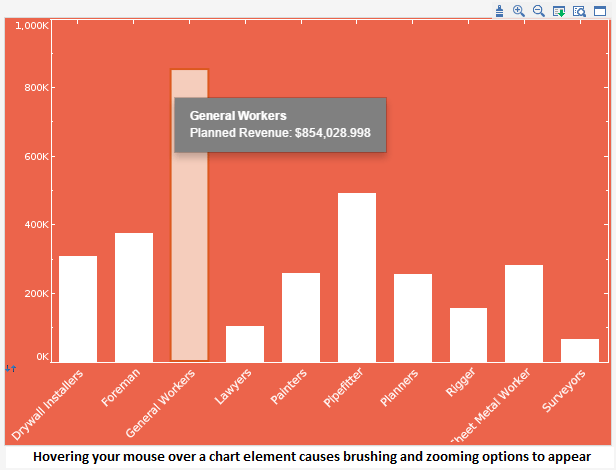Exploring Dashboards

Editing a Dashboard

-
Getting Started with Interactive Dashboards
This guide introduces users to the basics of navigating and interacting with dashboards using InetSoft's free app. It covers fundamental features like filtering, drilling down, and customizing views to explore data effectively. The article emphasizes the importance of user-friendly interfaces in enhancing data exploration. Practical tips are provided to help users maximize their dashboard experience.
-
Exploring Various Data Visualization Techniques
Delving into different chart types, this article highlights the significance of selecting appropriate visualizations for data analysis. It discusses various charts such as network charts, trellis charts, dot plots, word clouds, and icicle charts. The guide provides insights into when and how to use each chart type to uncover patterns and relationships within data. Examples illustrate the application of these visualizations in real-world scenarios.
-
Exploring Seven Analytical Methods
This article outlines seven distinct approaches to data analysis: cluster, cohort, regression, factor, neural networks, data mining, and text analysis. It explains the purpose and application of each method in deriving insights from data. The guide offers practical examples to illustrate how these methods can be implemented. It also discusses the benefits and limitations of each approach.
-
Exploring Interactive Dashboard Examples
Showcasing various interactive dashboards, this article demonstrates how different departments utilize dashboards to monitor key performance indicators (KPIs). It highlights the versatility of dashboards in providing real-time insights across various business functions. The guide emphasizes the importance of customization in aligning dashboards with specific departmental needs. Examples illustrate the application of dashboards in diverse organizational contexts.
-
Exploring the Data Visualization Gallery
This gallery presents a collection of industry-specific data visualizations, offering users a glimpse into the capabilities of InetSoft's visual analytics software. It showcases various visualization types and their applications in different sectors. The gallery serves as a resource for users seeking inspiration and understanding of effective data visualization. Each example is accompanied by a brief description highlighting its purpose and functionality.
-
Exploring Business Analytics and Big Data
In this article, the relationship between business analytics and big data exploration is examined. It discusses how businesses can leverage analytics to make sense of large datasets and derive actionable insights. The guide provides examples of tools and techniques used in big data exploration. It also addresses the challenges and opportunities presented by big data in the business context.
-
Exploring Emerging BI and Data Analytics Trends
This article explores the latest trends in business intelligence (BI) and data analytics, providing insights into the evolving landscape of data exploration. It discusses advancements in technology and methodologies shaping the future of BI. The guide highlights key trends such as artificial intelligence, machine learning, and real-time analytics. It also examines the implications of these trends for businesses seeking to enhance their data exploration capabilities.
-
Exploring the Three Dimensions of Analytics
Focusing on the three critical dimensions of analytics—degree of user interactivity, data volume, and calculation complexity—this article provides a framework for understanding analytical activities. It discusses how these dimensions influence the design and implementation of analytics solutions. The guide offers insights into balancing these factors to optimize analytical outcomes. Examples illustrate how different analytical activities align with these dimensions.
-
Exploring Top Tools for Data Analysts
This article presents a curated list of 16 popular analysis tools, highlighting their key features and applications. It provides an overview of each tool, offering insights into their strengths and suitability for various analytical tasks. The guide serves as a resource for data analysts seeking to expand their toolkit. It also includes examples of how each tool can be utilized in different analytical scenarios.
-
Exploring Completed Dashboard Examples
Showcasing completed dashboards, this article demonstrates how businesses can utilize dashboards to explore and analyze data intuitively. It highlights the benefits of completed dashboards in enabling quick recognition of strengths and weaknesses. The guide discusses how dashboards can be customized to meet specific business needs. Examples illustrate the application of completed dashboards in various organizational contexts.
-
Exploring Data Visualization for Media Companies
This guide focuses on the importance of data visualization in the media industry, emphasizing its role in creating engaging and interactive data presentations. It discusses strategies for designing compelling visuals that effectively communicate information. The article provides examples of how media companies can leverage data visualization to enhance their storytelling. It also addresses the challenges and considerations specific to the media sector.
-
Exploring Operations Dashboards
This article delves into the unique aspects of operations dashboards, explaining their purpose and how they differ from other departmental dashboards. It discusses the scope, design, and usage of operations dashboards in monitoring and analyzing business performance. The guide provides insights into the features and functionalities that make operations dashboards effective tools for decision-making. Examples illustrate the application of operations dashboards in various industries.
-
Exploring Popular Business Dashboards
Highlighting popular business dashboard examples, this article showcases how organizations use dashboards to monitor, explore, and analyze data. It discusses the advantages of using dashboards in providing real-time insights and facilitating decision-making. The guide emphasizes the importance of user-driven data mashups in enhancing dashboard functionality. Examples illustrate the application of popular dashboards in different business contexts.
-
Exploring Executive Dashboards
This article provides an overview of executive dashboards, explaining their role in monitoring team objectives, making adjustments, and forecasting outcomes. It discusses the features and functionalities that make executive dashboards valuable tools for strategic decision-making. The guide highlights the importance of real-time data presentation in executive dashboards. Examples illustrate how executive dashboards are utilized in various organizational settings.


